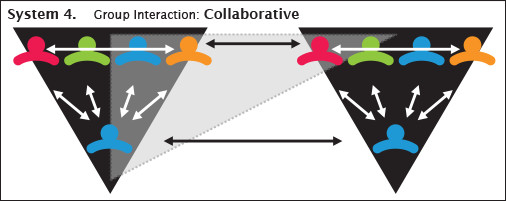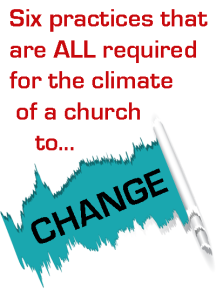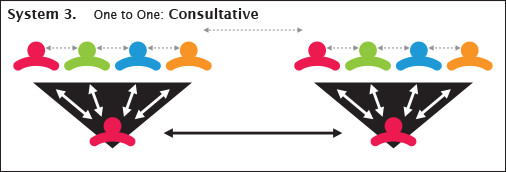A Foretaste! Transforming Leadership Practices: A Climate that Manifests the Reign of God
Posted by Inagrace Dietterich
The July 2015 Convocation sponsored by the Center for Parish Development explored leadership practices that cultivate Christian communities as a foretaste of the reign of God. As presenter, The Rev. Dr. Paul M. Dietterich, Executive Director Emeritus of the Center, shared results of extensive research over a 34 year period that demonstrate how the climate of a church shapes the life and ministry of that church.

LesslieNewbigin, formerly Bishop of the Church of South India, has written, “The church is only true to its calling when its common life is recognizable as a foretaste of the blessing which God intends for the whole human family.” He is writing about the interactions within each Christian congregation. The quality of relationships in each congregation are to be an example of life inside the kingdom of God. Newbigin uses the word “foretaste” to describe this aspect of congregational life. A foretaste is a slight experience, a sample of something to be enjoyed much more fully in the future. In this case, the church’s common life is to be an advance experience, a glimpse of life inside the kingdom of God.
Newbigin is offering a criterion for evaluating a congregation. What is most important is not how many members it has, or how large its budget is, or how many programs it offers, or how grand its facilities may be. What is most important is the dynamic life—the climate—of the congregation itself: how people support each other, share power and influence, learn together, worship together, make decisions, care for one another, manage conflict, actually demonstrate a different way to be a human community.
A Theological Challenge.
 For a church to become a foretaste of God’s kingdom, pastors and members alike need to develop different ways of thinking about what it means to be a “people called by God.” The church for centuries has taught that the “pastor” is called by God. The people are simply to follow the pastor’s instructions. As one wag has put it, the members exist to “pray, pay, and obey.” A missional ecclesiology offers a different way of thinking. Both the Old and New Testaments assert that God calls a “people” to become God’s witnessing community. The pastor is to support and equip the people of God for their mission as a sign, foretaste, and instrument of the kingdom. Such a congregation would be a credible sign of God’s reign of justice and mercy over the whole of life, an open fellowship whose concerns are as wide as the concerns of humanity. It would care for its neighbors in ways which reflect and spring out of God’s care for them, and its common life would be recognizable as a foretaste of the blessing which God intends for the whole human family. (Paraphrase of Newbigin)
For a church to become a foretaste of God’s kingdom, pastors and members alike need to develop different ways of thinking about what it means to be a “people called by God.” The church for centuries has taught that the “pastor” is called by God. The people are simply to follow the pastor’s instructions. As one wag has put it, the members exist to “pray, pay, and obey.” A missional ecclesiology offers a different way of thinking. Both the Old and New Testaments assert that God calls a “people” to become God’s witnessing community. The pastor is to support and equip the people of God for their mission as a sign, foretaste, and instrument of the kingdom. Such a congregation would be a credible sign of God’s reign of justice and mercy over the whole of life, an open fellowship whose concerns are as wide as the concerns of humanity. It would care for its neighbors in ways which reflect and spring out of God’s care for them, and its common life would be recognizable as a foretaste of the blessing which God intends for the whole human family. (Paraphrase of Newbigin)
A Leadership Challenge.
For a church to become a foretaste of God’s kingdom, pastors and councils, along with members, will need to develop a climate within each congregation that demonstrates life inside the kingdom. The climate of a church is like the weather. Some congregations are cold and indifferent. Others are warm and inviting. Like the weather, the climate of a congregation has an impact on the people who experience it. A church’s climate also affects the ways people participate in it.
Beginning in 1973, the Center for Parish Development began working with Jane and Rensis Likert of the Institute for Social Research at the University of Michigan. Some of the best research on organizational climate was being done under their direction. Using adaptations of the Likert’s questionnaires, the Center has been gathering research data on the leadership practices of pastors and other church leaders. We have learned that, while external factors have an influence on a congregation’s climate, the single most important determinant of climate is the practices of the pastor and other key leaders. Some leadership practices enable people to experience their congregation’s climate as a foretaste of life inside God’s kingdom. Other leadership practices create the opposite.
 The “work” of most church organizations is planned and carried out by groups. In fact, most congregations and other church organizations actually are networks of interrelated and interdependent work groups. The work group (committee, board, council, session, professional staff, etc.) is the basic unit of a church organization. Every congregation has at least one work group or team—the council, board, session, etc. Some congregations have more than 80 work groups, each one needing to be developed as a high-performing team. The pastor, who is “head” of the congregation, and the chairpersons (team heads) of each work group exert a major influence in setting the tone, atmosphere, or climate, of that work group. This is evidenced by the pastor’s and the team heads’ behavior toward the team members.
The “work” of most church organizations is planned and carried out by groups. In fact, most congregations and other church organizations actually are networks of interrelated and interdependent work groups. The work group (committee, board, council, session, professional staff, etc.) is the basic unit of a church organization. Every congregation has at least one work group or team—the council, board, session, etc. Some congregations have more than 80 work groups, each one needing to be developed as a high-performing team. The pastor, who is “head” of the congregation, and the chairpersons (team heads) of each work group exert a major influence in setting the tone, atmosphere, or climate, of that work group. This is evidenced by the pastor’s and the team heads’ behavior toward the team members.
The selection of key leaders is very important. They need to be selected on the basis of their skills in building and working with teams. Since the particular focus and work of teams is usually determined by the central leadership team, team heads usually have limited authority. But team heads do have the opportunity to cultivate a faithful and fruitful team. If team members do not like or respond well to the formal team head, it is likely that an informal leader will arise within the team. If the formal team head is harsh and coercive, it is likely that the team will resist his or her leadership and rally around an informal leader in ways that are harmful to the larger concerns of the congregation.In contrast, if the pastor and the team heads are supportive, reassuring, positive and stimulating, the teams will be attractive to their members. They will develop a closeness, cohesiveness, confidence, and trust that will result in pride in their group and loyalty to the teams’ aims and objectives.
Four Leadership Systems.
The practices of pastors and team leaders can be viewed in at least four leadership systems:
System 1-Coercive. The church leader who practices System 1 behavior is often dominated by fear of failure. He or she mistrusts the group and therefore attempts to control it in order to avoid failure. Communication is primarily downward from the team head to the members. But coercive leadership leads to a climate characterized by hostile attitudes toward the leader, dissatisfaction among team members, suspicion and distrust of the leader, powerlessness, sometimes deliberate deception, covert resistance, no cooperative teamwork, low motivation, and negative attitudes toward the church.
System 2-Competitive. The pastor or other church leader who practices System 2 behavior encourages competition among team members as well as competition with other leadership teams in the church. Team members view each other as rivals. Most communication is downward from the leader to the team members. There is little cooperative teamwork partly because the leader makes little effort to build the work group as a cohesive missional team. The leader pays more attention to some team members than others, listening to them while largely ignoring what other members say. This leads to a climate characterized by distrust, suspicion, rivalry,distortion of information, and dissatisfaction with the team head, peers, and the church.
System 3-One to One Consultative. A System 3pastor or other church leader builds a relationship with each team member separately. Each team member therefore feels free to share important work-related information with the pastor and the team head. Goals are set and plans are made by the leader after discussion with each member separately. Team members usually accept the leader’s goals and plans, although there may be some resistance. There is only a moderate amount of teamwork and only limited attempts to build the team as a cohesive working unit. Control of the team is with the leader, although team members have limited influence because of their one-to-one conversations with the team head. System 3 is inherently unstable as a management system because all the information resides in one person. There is, however, a climate of increased trust and increased cooperation.
System 4-Group Collaborative. The pastor and/or team head expresses support for each person’s sense of dignity and giftedness. The leader seeks and uses the ideas of team members. The leader builds work groups as high performing and cohesive teams. Power is shared with the team. Decisions are made by the leader and team together using group methods of decision-making. Responsibility is shared with the team. The leader intentionally builds strong one-to-one relationships with each team member individually. However, the leader also encourages communication in all directions as information is shared up, down, and sideways in the team.The goals are set by the team. Influence is shared in the team. This contributes to a climate characterized by high motivation, high trust, team productivity, creativity, team cohesiveness, and support.

Diagrams – Copyright © 2015 The Center for Parish Development. All rights reserved. Created in cooperation with Rensis Likert and the Institute for Social Research, University of Michigan.
System Zero. A fifth system is employed by some pastors and church leaders. This system is laissez-faire.It is characterized by an absence of leadership. Recent research conducted in Norway indicates the destructive nature of this system. A laissez-faire church leader systematically works against the attainment of the congregation’s goals, values, and optimal use resources by neglecting them. This sabotages the motivation, well-being, and work satisfaction of others who, hoping to achieve the church’s goals, find themselves without leader support. The leader, while elected, appointed, or called to a position of leadership, in practice actually abdicates his or her responsibilities. Such a person may avoid decision-making, show little concern for goal-attainment and seldom involve himself or herself with work groups, even when it is necessary. Laissez-faire leaders actually violate the legitimate interests of the church and the expectations of its members. The congregation is left to sink. Laissez-faire leadership is no leadership at all. It is the opposite of missional leadership.
Leader Causal Practices.
Six behaviors by the pastor and other key leaders have the most impact on congregational climate.In social science terms, these six leader behaviors when practiced consistently over time are “causal”—they cause change in the system. If a pastor inherits a congregation that has been managed via System 2-Competitive, by practicing these six behaviors consistently he or she can help the congregation make its way up the scale from System 2 to System 3 and finally to System 4. In most congregations, this progression takes at least four years. It takes time for a church body to learn the new ways of thinking and behaving. New skills are required to make this significant transition.
These six practices form a systemic whole. They reinforce one another. All six are required for the climate of a church to change.
- Support by Leader. The pastor (or other church leader)expresses support for persons. The members experience the leader as consistently supportive of their sense of dignity and giftedness.
- Receptivity. The leader actively seeks and uses members’ ideas. The members experience the leader as being available and easy to talk to.
- Performance Expectation. The leader emphasizes his or her own performance and expects high levels of performance from others in doing the work of the church.
- Teambuilding. The leader invests time and energy in building the council and other church work groups as high-performing and cohesive teams.
- Work Facilitation. The leader provides teams with the training and resources they need to do their work at high levels of performance.
- Group Decision Making. The leader uses group methods of goal-setting and decision making with the council and other work groups and expects all teams to take full responsibility for their work.
At first blush these six practices appear to be obvious and natural. The opposite is true. Every leader, council, work group, and congregation is challenged by the complexity and difficulty of learning and consistently practicing these behaviors. They will be explored further in subsequent blog posts.
Questions for Reflection and Discussion
- What is meant by the “climate” of a congregation? Why is it important? How is it theological?
- What is the role of the pastor within missional congregations?
- Identify when you have experienced System 1 leadership. How did it impact your participation in the work of the team?
- In what ways does the American cultural context encourage System 2 behavior?
- What is the difference between System 3 and System 4 leadership behavior?
- How do you respond to the statement that leadership behavior is “causal”?
- Which of the six leadership behaviors catches your attention?
- How do they shape a climate that manifests life within the reign of God?
Paul Dietterich, Th.D.,
Executive Director Emeritus An ordained minister of the Iowa Conference, The United Methodist Church, Paul has served pastorates in Massachusetts and Iowa. He holds degrees from Ohio Wesleyan University and Boston University School of Theology. (An earned doctorate in the field of planned change in church organizations.) Paul served as Executive Director of the Center from 1976 to 2005 and is a major contributor in the field of practical theology.

Inagrace Dietterich
The Rev. Inagrace Dietterich, Ph.D. is the Director of Theological Research at the Center for Parish Development.







Paul, thanks for sending this. It seems like we in the ELCA love to throw around hot buzzwords to sound relevant and up-to-date, but often without a lot of substance or direction. The buzzword this year, of course, is “TRANSFORMATIONAL”. This word is dropped into articles in The Lutheran magazine, bishops’ letters, and fundraising circulars, and otherwise spoken of as if “everyone knows what we’re talking about”. You have actually made an excellent in-road into describing what it can look like and, most importantly, suggest that most of us are not going to get there from where we are and by what we are currently doing (or not)…that change is necessary and that real WORK and potential conflict (to move entrenched program, family or pastor-centric congregations) is unavoidable. Those that engage will survive to, hopefully, thrive while those that do not will likely die on the vine. vR
Lew Messinger
Date: Wed, 21 Oct 2015 19:36:21 +0000 To: lrm1995@hotmail.com
LikeLiked by 1 person
Hi Lew,
Thank you for your comment on my recent blog. I found your observations quite interesting and confirming of the Center’s experience over the past four decades. This is not a time in history for lazy pastors. The kinds of changes required are very demanding. After all, “transformation” has to do with new ways of thinking, new ways of perceiving, and new ways of behaving–all three. Not easy.
Paul
LikeLiked by 1 person